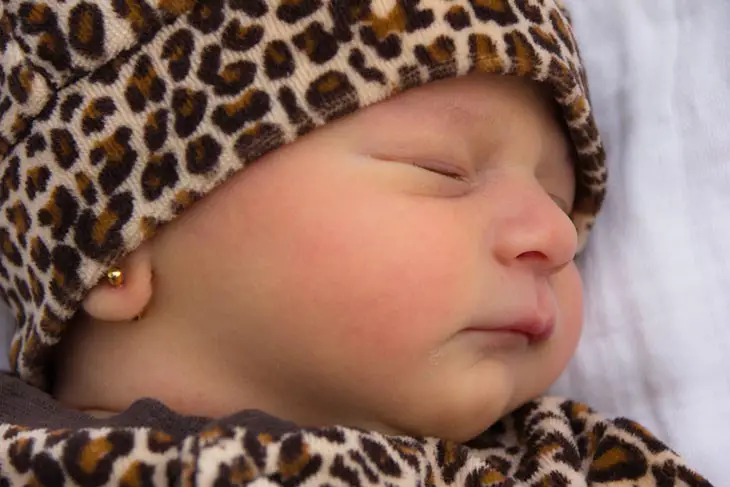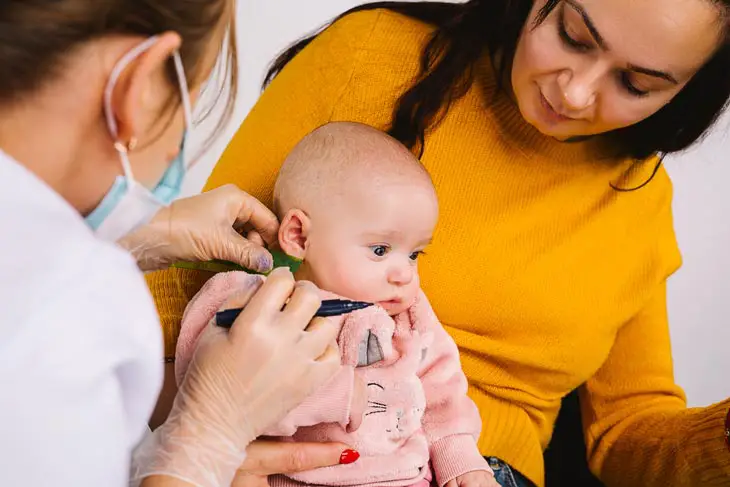Beautifying the baby with adorable accessories like earrings is one of the most popular things done by parents.
However, the baby’s skin is much more sensitive and vulnerable than ever. That’s why we had better consider if it is safe when piercing baby ears at 3 months.
This article not only provides the answers but also outlines the health risks that children may face after having their ears pierced. Safe care solutions are also suggested afterward.
Piercing Baby Ears At 3 Months: Should You Do That?

Technically, yes. Babies can get their ears pierced from 2 months old. Nevertheless, our advice is that parents had better wait until the child is a few more months old (at least 3).
This is when the skin and immune system can function and withstand external impact more stably and effectively.
As such, they can minimize the infection or irritation by metal. Some parents even apply this practice from their kids’ infancy, but we don’t recommend doing so.
When Is The Best Time To Pierce A Baby’s Ears?
Best Age To Pierce Baby’s Ears
Ear piercing at any time depends on the parents’ personal decision. Some families desire to get their infant’s ears pierced before he/she becomes a toddler.
If that is your case, please do this procedure when your baby is 10-12 months old.
When you are too busy to take care of your little one after a piercing, you can leave your baby with his grandparents and ask for help.
If you do not put an emphasis on this stuff, you may think of piercing your 6- or 7-year-old child.
At this time, the wound is less painful and heals more quickly, thanks to the thicker earlobe.
Besides, safety is also considered absolute. You can spend less effort because your kids can also monitor and care for their piercings.
How Long Does Ear Piercing Heal Babies?
There are some presumptions that the infant’s skin is significantly more adaptable and resilient than that of older kids. So, piercing wounds can be self-healed in a short time.
On average, ear piercing for infants takes 6 weeks at most to heal completely (for earlobe position).
It will take more time if the piercing is on the ear flaps with less skin coverage.
Additionally, the healing time can be lengthened or shortened depending on the natural body condition coupled with the aftercare.
Risks Of Getting Pierced For 3-Month-Old Babies?
Infection
This is the most common and dangerous complication that a newborn can face.
Signs can include itching, pain, swelling, redness, or even worse, white or yellow pus discharge, usually appearing after 2 weeks.
The infant may not be used to this discomfort; by means, they constantly touch, rub or scratch the wound with their hands.
The action makes the infection more serious, profoundly affecting the baby’s physical and mental health.
There are several causes for this situation, typically careless usage of old, rusted, or unsterilized tools.
The piercing area is not cleaned or sterilized before the procedure also results in the infection.
Newborns with little awareness could let bacteria enter the wound through their dirty hands. Or else, the infant constantly moves the earrings when the piercing has not healed yet.
That skin area is extremely sensitive, so these actions can also lead to infection.
Allergy
The nickel allergy can be a reaction between the body conditions to the metal elements of the earrings, especially when using nickel earrings.
You probably find eczema skin lesions on the earlobes. In addition, the affected skin can also suffer from itching, which is more intense if not treated immediately.
Once there are hives or clusters of blisters on the ears, you can also identify the allergy’s symptoms.
As you know, a baby possibly scratches a lot, causing more painful tearing on the skin.
Bleeding
The ear may bleed a little due to the first time ear piercing. However, you had better consider this issue if bleeding lasts more than 1-2 days later.
There are some cases where bleeding suddenly appears 1-2 weeks after the procedure.
The piercing may be too tight, or there is a slight scratch inside, causing the constant bleeding.
Definitely, it can threaten the baby’s health, so please have the doctor see your baby as soon as possible.
Formation of Keloids
A keloid is usually a small round growing around the piercing site.
The body produces scar tissue to replace the injured skin. Yet, the incomplete body of a 3-month-old baby can generate an abundance of scar tissue.
This excess amount tends to spread beyond the original wound, causing a larger swelling than the original puncture – known as a keloid.
Sometimes they appear quickly, but usually, they form a few months after the ears get pierced.
Unfortunately, they probably grow in size over time, and the treatment is also regarded as more time-consuming and complicated.
Ear Deformation
It is not a common risk unless an infant pierces too many holes before maturing.
Deformity in ear-pierced babies is usually the earlobes’ sagging due to the earrings’ impact (especially the drop and dangle earrings.
How To Get Baby’s Ears Pierced?
Instructions
The ear-piercing procedure for a 3-month-old baby is also performed similarly to for older children or adults. In general, the expert carries out 3 main steps.
The main stage begins after the earlobe is disinfected with alcohol. There are two most popular ways today, piercing with a needle or a piercing gun.
Parents can consider the specialized center with a suitable method.
In general, both ways can be a bit painful for the baby because it is directly through the skin.
The doctor will attach the earring to shape and prevent the hole from becoming clogged in the final step.
The baby may move a lot because of the discomfort.
Therefore, parents should embrace and hold tightly to avoid technical errors (especially when using needles) during the piercing process.
Advice For Safety Ear Piercing For Babies
Check the body condition of the baby
Considering the newborn’s physical condition is one of the first and foremost steps. Make sure your baby is in good health and remarkably non-allergic to metals.
You should also give up the idea of piercing if the baby has weak skin, which is often prone to congenital skin diseases (rash, urticaria, etc.).
Choose a reliable piercing center
Undoubtedly, a well-known and reliable center can ensure maximum safety for your baby. You can choose a medical center or a private center.
High-quality services will offer experienced piercing specialists who possess skillful, gentle, and smooth techniques.
Most importantly, facilities and tools are always sterilized before usage, committing to the most hygienic environment for the piercer.
Then the doctor can also give you useful and proper advice for the aftercare plan.
Check the sanitary piercing tools
The clean tool is the first thing you need to check when visiting any center. You can ask an expert to reveal the tool cleaning process.
That way, you can prevent the child from taking risks like infection or bleeding.
Prepare for relieving pain afterward
Your baby may react to the wound with symptoms such as fussiness or a slight fever. If so, do not wrap them with blankets or put socks on your high-temperature baby.
Keeping the piercings clean in the first weeks can stimulate the healing process and prevent infection.
You can use a saline solution to wash the newborn’s ears every day (at least once a day) for 1-2 weeks for the wound to heal.
Be careful not to let objects get in the way or let your baby rest on the earrings.
When an object gets caught in the earring, the piercing can be pulled apart, causing pain for the child and damaging the piercing.
Conclusion

In conclusion, deciding the age for piercing is still with the parents. However, we believe that it is quite early when it comes to piercing baby ears at 3 months.
You can wait for the child to get a little older. A kid can get a piercing at any stage in his or her growth. In infancy, safety should still be a priority.
It is better to prepare some healing or anti-inflammatory cream at home if the child unfortunately encounters the above risks.
Please take your baby to the hospital immediately in emergencies. Having the doctor clean the baby’s ears periodically is also recommended.
